Due to their low cost and reliable connectivity, optical cables are fast becoming a practical solution for many wiring projects. Once you decide to use fiber routing, you need to decide whether to use a single mode or multiple modes. With so many options, it can be difficult to select the most appropriate multimode fiber. OM1 vs OM2 vs OM3 vs OM4 vs OM5, which to choose? You may get the answer in this article.
HOW DOES FIBER OPTICS WORK?
As explained by the Fiber Optics Association, fiber optics is a communications medium that sends optical signals down hair-thin strands of an extremely pure glass core. The core is surrounded by a cladding that traps light in the core.
CORE & CLADDING SIZING
Fiber types are identified by the diameters of the core and cladding, expressed in microns. Multimode fiber is available in two sizes, 62.5 or 50 microns, and four classifications: OM1 (62.5/125 µm), OM2, OM3, OM4, OM5 (50/125 µm). The diameter of a single mode core is 9µm. Both fiber types have a cladding diameter of 125 µm or microns.
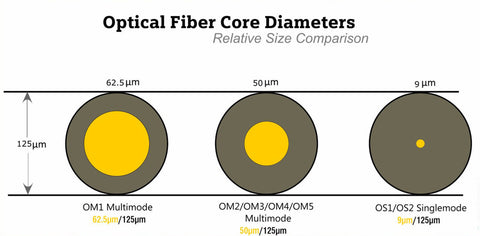
Why use optic fiber cable?
Signals can be transmitted over longer distances than with copper cables.
It has high carrying capacity (Extremely High Bandwidth:, THz or Tbits/s)
They have very low transmission losses (<0.2dB/km, cf1dB/km microwave, 10db/km twisted copper pair).
They do not dissipate heat.
They are immune to cross talk and electromagnetic interference. The fiber transmission is virtually noise free.
Optical fiber types
Based on the light travel through one path (that is mono mode or single mode fiber) or more than one path (that is called multi mode fiber) along with core diameter fiber optic cable are divided into two major categories.
Single Mode vs Multimode Fiber Cable
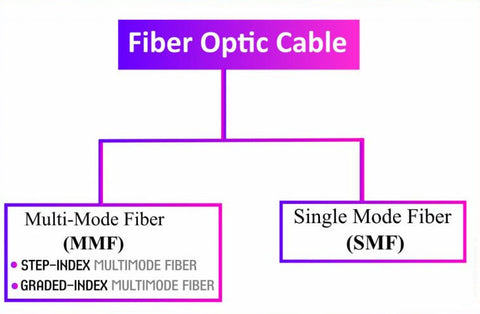
Multimode (MM) fiber optic cable
Single Mode (SM) fiber optic cable
First of all, what is single mode?
Single Mode Fiber is an optical fiber that allows only one mode of transmission. The core diameter is about 8 to 9 μm and the outer diameter is about 125 μm. Multimode Optical Fiber allows different modes of light to be transmitted over a single fiber with a core diameter of 50 μm and 62.5 μm. Single-mode fibers support longer transmission distances than multimode fibers. From 100Mbps Ethernet to 1G Gigabit, single-mode fiber can support transmission distances of more than 5000m.
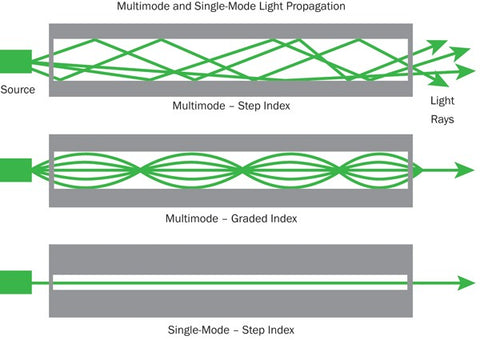
What is Multimode Fiber?
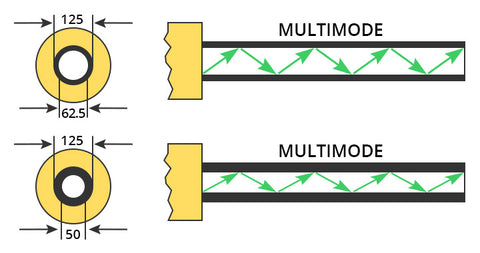
A fiber carrying more than one mode is called a multimode fiber. Multimode (MM) fiber optic cable has a fairly large core diameter that enables multiple light modes to be propagated. Multimode fibers have a much larger core diameter. Two types of Multimode cables with core diameters of 50 microns and 62.5 microns were specified.
Multimode fiber is only suitable for medium and short distance and small capacity fiber optic communication systems.
How Many Types of Multimode Fiber?
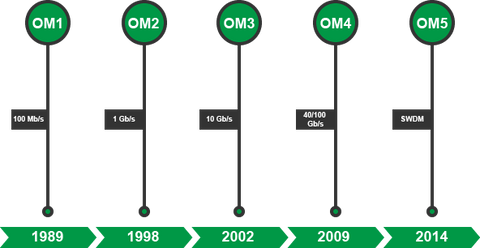
The multimode fiber is classified into 5 categories.
- OM1 Fiber– Usually comes in an orange jacket, according to industry color-coding standards, and can support a 10Gb Ethernet at lengths up to 33 meters (110 ft). This type commonly uses an LED light source.
- OM2 Fiber – Able to carry 10Gb Ethernet up to 82 meters (270 ft) on an LED light source. It can be found in orange and aqua jackets.
- OM3 Fiber– Supports 10Gb Ethernet at lengths up to 300 meters. Instead of LED lighting, the OM3 cable's design makes it optimized for laser transmission to help support 10Gb, 40Gb, and 100Gb Ethernet up to 75 meters. The OM3 cable is distinguished by an aqua jacket.
- OM4 Fiber– Sharing the same aqua jacket as OM3, OM4 also supports laser transmission beyond 150 meters and can carry 10Gb Ethernet up to distances all the way up to 550 meters. For higher bandwidth applications, OM4 can still transmit 100Gb up to 100 meters. Some versions of OM4 cable have a magenta jacket. OM4 fiber is commonly called 'laser optimized.
- OM5 Fiber– The latest iteration of the OM cable, OM5 packs some muscle that can carry high bandwidth for short to medium distances. What sets the OM5 apart from the rest is its ability to achieve high bandwidth over short distances using fewer cables. Traditionally, 400Gb Ethernet has been achieved using 16 transmit and receive cables, but with the OM5 cable you can achieve this with just four transmit and receive cables. It always comes in a lime-green jacket.
Comparison between different types of OS fiber optic cables
OS1
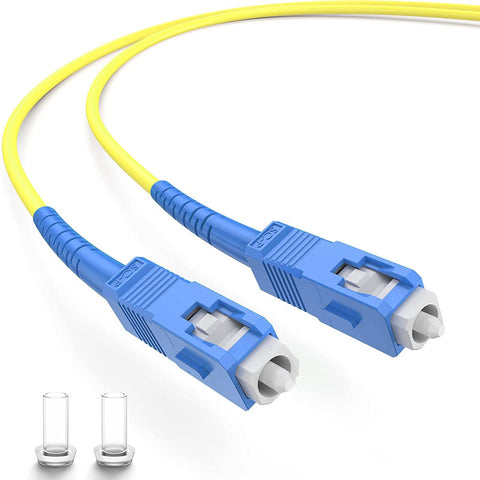
Core Size – 9µmOS1 Tight buffered fiber
Jacket Color - Yellow for jumpers, but use multiple colors depending on the application and type of outer jacket.
Data Rate – 10Gps
Wavelengths - 1310 nm and 1550 nm
Distance – Up to 2,000 meters
Cable construction - tight buffer construction OS1 fiber cable
Applications - designed for premises, indoor use, moderate distance telco local loops, LANs and point-to-point links in cities, buildings, factories.
OS2
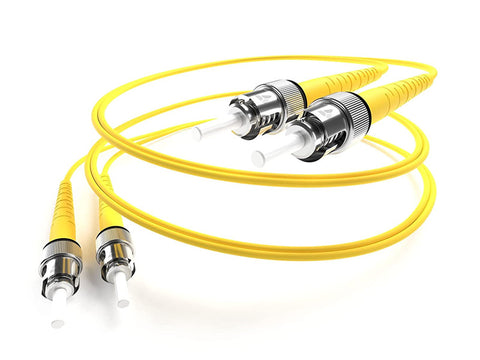
Core Size – 9µm
Jacket Color – yellow for jumpers but uses a variety of colors depending on the application and the outer jacket type.
Data Rate – 10GpsOS2 fiber cable
Wavelength – 1310 nm and 1550 nm
Distance - 5,000 to 10,000 metres
Cable construction-the construction of loose tubes or blown cables
Applications - designed for premises, outdoor or indoor, long distance telco backbone, LANs and point-to-point links in cities, buildings, factories. OS2 can support speeds up to 100G and distances up to 200km (124 miles).
OM1 vs OM2 vs OM3 vs OM4 vs OM5: What's the difference?
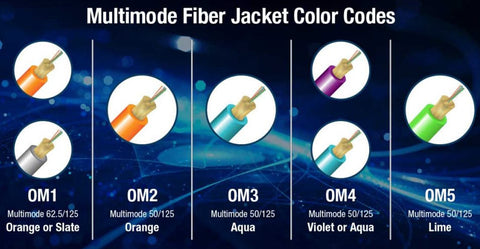
The main difference between multimode fibers is the physical difference. Thus, physical differences lead to different data rates and distances.
Physical difference
The physical differences are mainly in diameter, cladding color, optical source and bandwidth, as described in the table below.
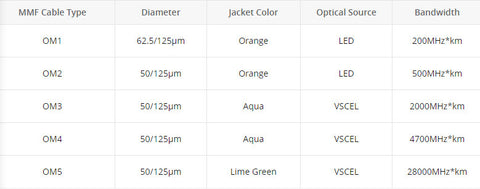
Practical difference
Multimode fibers are capable of transmitting over different distances at different data rates. Depending on your current app, you can choose the most appropriate one. A comparison of the maximum distance of a multimode fiber at different data rates is defined below.
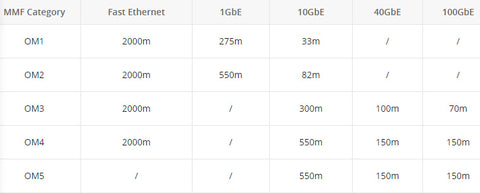
What is the difference between OM3 and OM4?
- Different jacket color
To distinguish between different fiber jumpers, different colors of the outer sheath are used. For non-military applications, the single-mode fiber is typically a yellow outer jacket. In the multimode fiber, OM1 and OM2 are orange, OM3 and OM4 are water blue, and OM5 is water green.

- Different application scope
OM1 and OM2 have been widely deployed in buildings for many years and support up to 1GB of Ethernet traffic. OM3 and OM4 fiber optic cables are typically used in data center cable environments to support 10G and even 40/100G high speed Ethernet paths. Designed for 40Gb/s and 100Gb/s transmission, OM5 reduces the number of fibers that can be transmitted at high speeds.
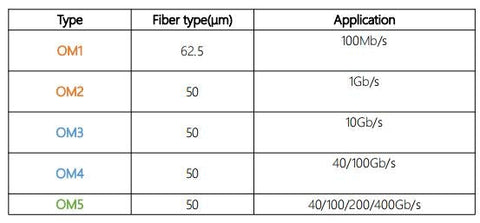
What Is OM5 Fiber?
According to ISO/IEC 11801, OM5 fibers are specified for a wider wavelength range between 850nm and 953nm. It was created to support short wavelength division multiplexing (SWDM), which is one of the many new technologies being developed for transmitting 40Gb/s and 100Gb/s. In June 2016, the new wideband multimode fiber standard ANSI/TIA-492AAAE was approved for publication. And in October of 2016, OM5 fiber was announced as the official designation for cabling containing WBMMF (Wide Band Multimode Fiber) by ISO/IEC 11801. From there, OM5 could be a potential new option for data centers that require larger link distances and higher speeds.

OM4 vs. OM5: What's the Difference?
Since OM1 and OM2 fibers do not support 25Gbps and 40Gbps data transfer speeds, OM3 and OM4 are the premier options for multi-mode fibers supporting 25G, 40G and 100G Ethernet. However, as bandwidth requirements increase, it becomes more costly for optical fiber cables to support next-generation Ethernet speed migrations. Against such a backdrop, OM5 fiber was born to extend the benefits of multimode fiber in data centers.
The key difference between them is that the EMB is specified only at 850 nm for the OM4 fiber at 4700 MHz-km, while the OM5 EMB is specified at both 850 nm and 953 nm, with the 850 nm value being larger than the OM4 value. As a result, OM5 fiber offers users longer length distances and more options in fiber. In addition, the TIA has designated lime green as the official cable jacket color for the OM5, while the OM4 is aqua. While OM4 is designed for 10Gb/s, 40Gb/s, and 100Gb/s transmission, OM5 is designed for 40Gb/s and 100Gb/s transmission, which reduces fiber counts for high-speed transmission.
More importantly, the OM5 cable can support four SWDM channels, each carrying 25G of data, to deliver 100G Ethernet using a single pair of multimode fibers. Moreover, it is fully compatible with the OM3 and OM4 fibers. . . . OM5 is available globally for installations in multiple enterprise environments, from campuses to buildings to data centers. In conclusion, the OM5 fiber is a better choice than the OM4 in terms of transmission distance, speed and cost.
- Less bandwidth supports higher bandwidth applications.
The OM5 fiber patch has an operating wavelength of 850/1300 nm and can support at least four wavelengths. The typical operating wavelengths for OM3 and OM4 are 850 nm and 1300 nm. That is, the conventional OM1, OM2, OM3 and OM4 multimode fibers have only one channel, while OM5 has four channels, increasing the transmission capacity by a factor of four. Combining short wavelength division multiplexing (SWDM) and parallel transmission technology, OM5 only requires 8-core wideband multimode fiber (WBMMF), supports 200/400G Ethernet applications, and greatly increases the number of fiber cores. Reduce. To a lesser extent, it reduces the cost of network cabling.
- Further Transmission Distance
The transmission distance of the OM5 fiber is longer than that of OM3 and OM4. The OM4 fiber is designed to support 100G-SWDM4 transceivers with a length of at least 100 meters. However, with the same transceiver, the OM5 fiber can support a length of up to 150 meters.
- Reduced attenuation of OM5 broadband multimode cables with low fiber losses.
From 3.5 dB/km for the previous OM3, the OM4 cable increases to 3.0 dB/km, increasing the bandwidth requirement to 953 nm.
The OM5 has the same fiber size as the OM3 and OM4, so it is fully compatible with the OM3 and OM4, and no changes are required for the OM5 in existing cable applications. OM5 fibers are more scalable and flexible and can support high-speed network transmission with fewer multimodal fiber cores. The cost and power consumption are much lower than single-mode fibers, so it will be widely used for 100G/F in the future. 400G/1T ultra-large data center.
Singlemode vs Multimode: Which Fiber Optic patch cable should I use in my rack?
Single Mode and Multi Mode Fiber technologies have completely revolutionized the world’s capability for communication. Which Cable type you should use depends entirely on your needs and your budget, but if you need high-throughput communication, Fiber is certainly worth checking out!

